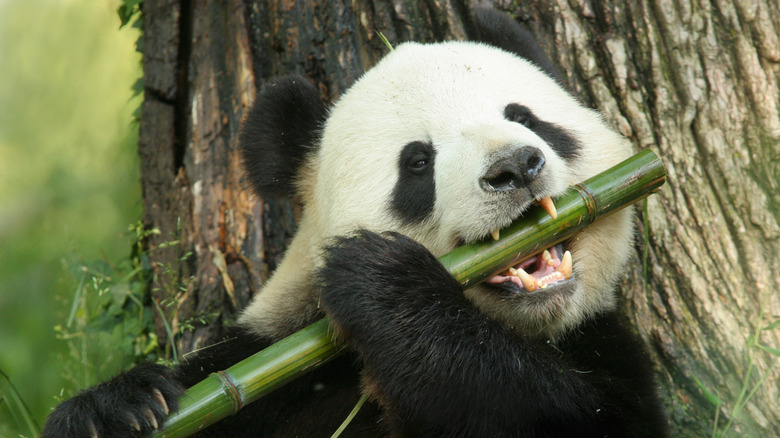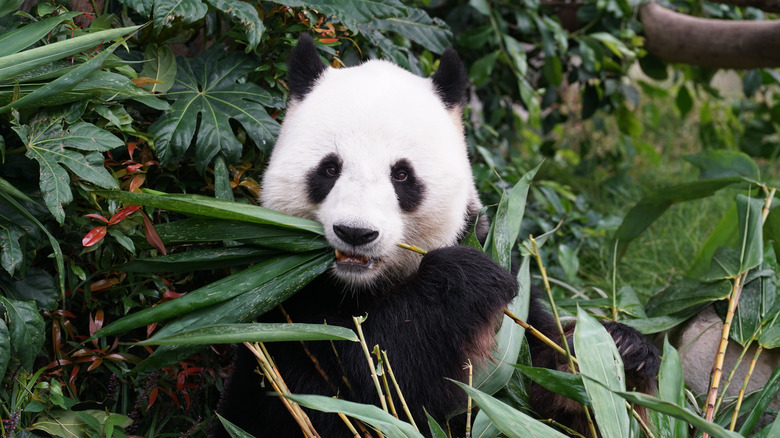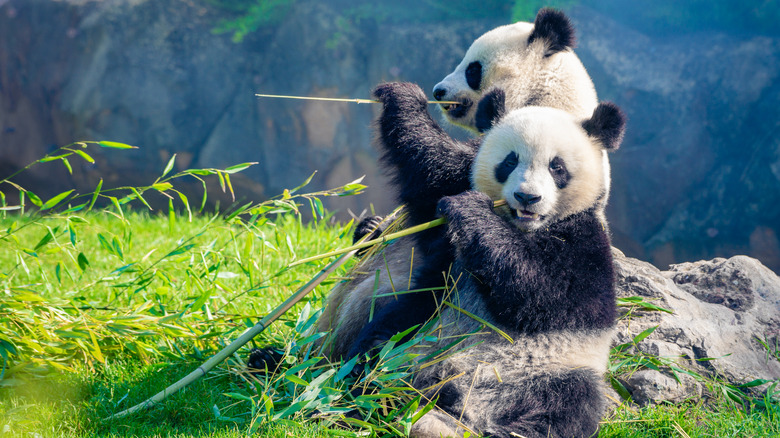Giant Pandas Eat A Staggering Amount Of Bamboo Each Day
Giant pandas are some of the most fascinating creatures on the planet. These large bears have an immediately recognizable black and white coat and are considered a national treasure in China, an important part of Chinese culture (via World Wildlife Fund). As a vulnerable species on the IUCN Red List, extensive conservation efforts have been aimed at increasing panda population numbers and reducing threats, such as habitat loss.
One of the hallmarks of the giant panda is its ability to chow down on a staggering amount of bamboo every day. According to the World Wildlife Fund (a panda serves as part of the organization's logo), giant pandas can eat around 26 to 84 pounds of bamboo per day. This is due to their large size, with females weighing an average of 200 lbs and males weighing around 300 lbs (via Panda Things). Additionally, the giant panda's diet consists almost entirely of bamboo, so they require a lot of it in order to meet their daily caloric needs.
Giant pandas are mostly vegetarian
According to the World Wildlife Fund, a giant panda's diet is about 99% vegetarian. This includes all parts of the bamboo plant — the roots, stems, shoots, and leaves. Pandas can also eat other types of plants, such as vines, corn, and flowers, but need to have bamboo make up the majority of their diet (via Realonomics). Pandas are also known to find themselves in farmland, where they eat crops such as pumpkins, wheat, and beans.
The remaining 1% of a giant panda's diet comes from non-plant sources, such as eggs and small animals. Because pandas belong to the same family as other types of bears, their digestive system allows them to digest meat. In fact, there are no differences between the digestive tracts of pandas and other bears, meaning their bodies are designed to be carnivorous. Yet they still prefer bamboo over meat. According to The University of Melbourne, this may be due to the fact that pandas are not able to taste meat, so it is just not very interesting for them.
Giant pandas could go extinct without bamboo
Since bamboo is such a critical food source for the giant panda, the species is threatened greatly by anything that reduces the amount of bamboo available in the wild. While human efforts to protect panda habitats have helped increase wild populations, a study published in the journal Biological Conservation (posted at Science Direct) found that bamboo forests, the habitat of the giant panda, have shrunk by 34% due to free-range livestock trampling through protected areas.
While giant pandas are no longer considered endangered, they are still a vulnerable species (via The Guardian in 2021). According to Animal Fact Guide, the main reason for the reduced panda population is habitat destruction primarily caused by humans. In the Biological Conservation study, the researchers recommended "carefully implement[ing] a livestock ban and prioritiz[ing] removing horses [from protected areas] because they cause the greater harm." This is just one of the ways that we as human beings can help our furry friends to thrive.


